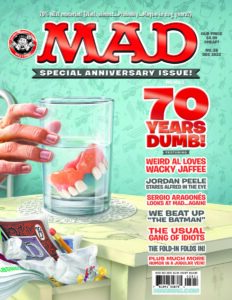
My friend Mark Evanier wrote a piece recently on the birth of Mad magazine, which just celebrated its 70th birthday. In reading that history, it occurred to me that Mad was the perfect example of a product you couldn’t do consumer research about before its creation.
Many years ago, I worked for a radio station where the general manager was data crazy. He wouldn’t make any moves without asking the public for its opinion, and at one point, tried to do a survey in which potential listeners told the station what they wanted. When the results were tallied, every suggestion was something that was on the air on another station — because that’s what they already knew. You can never create something fresh and different that way.
Just take a look at the apps on your phone to see plenty of examples of ideas that continue to disrupt entire industries by being unique and distinctive. Think about some of the things that changed our culture, not because they were based on research, but through an entirely different paradigm built from ideas never before attempted or very often the opposite of what others had done.
If you had asked young people in the early 1950s what they wanted in a magazine, they would not have said clever parodies, fold-in humor, silly characters drawn in the margins, and a freckle-faced mascot on every cover. They had no reference to guide them in a new direction. The same applied to National Lampoon two decades later, although Mad was certainly an influence.
In that era, pop music was dominated by artists who performed songs written by other people. Chuck Berry, Little Richard, and The Beatles changed that. Later, in the early years of rap, originals like Grandmaster Flash, Russell Simmons, and Run DMC introduced yet another seismic shift into the music landscape.
No art enthusiast would have told you they were pining for the kind of paintings that Pablo Picasso did.
Even after something novel is born, the public often still doesn’t get it. “Seinfeld” and “Everybody Loves Raymond” both tested terribly, yet went on to long runs in primetime and syndication.
If you asked the public to help design a new sports craze, how close would their responses have been to the phenomenon that is pickleball?
How many young people were begging for a book series about a school for young wizards before “Harry Potter”?
Show me a single person who expressed their desire for a mock documentary about a rock band before “This Is Spinal Tap.” Or a satire of disaster movies before “Airplane.” Or westerns before “Blazing Saddles.”
Do you remember any coffee drinkers demanding pumpkin spice lattes before Starbucks introduced them?
Did anyone in your world yearn for Pokémon cards, Chia Pets, or dolls like the Cabbage Patch Kids before they were invented?
Returning to radio, would any focus group have ever begged for a personality like Howard Stern — even before he figured out what he would be capable of?
After a product has been made, you can ask whether people liked it. Maybe do a few tweaks, then ask again. But nothing revolutionary has ever been birthed by a random group of people who can only tell you what they like or dislike in what already exists.
You should never count on them to have the vision to foresee a next big thing.
